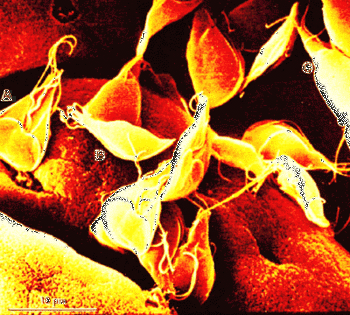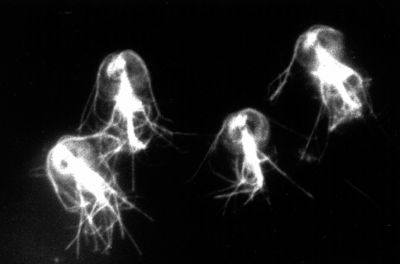Giardia*
A Microbial Biorealm page on the genus Giardia*

Classification
Higher order taxa
Eukaryota; Diplomonadida group; Diplomonadida; Hexamitidae; Giardiinae; Giardia
Species
|
NCBI: Taxonomy |
Description and significance
Giardia was first observed in 1632 by the Dutch tradesman, Antony van Leeuwenhoek, (father of microbiology), while he was examining his own feces under a microscope. In 1859 a Czech doctor named Lambl encountered the organism while studying the stools of children with diarrhea. Due to his extensive research concerning the organism, it was named Giardia Lamblia. Giardia however was not identified as a disease causing microbe (pathogen) until the 1970s.
Giardia Lamblia is a one celled organism that causes gastrointestinal flu or giardiasis characterized by nausea, abdominal cramps, and diarrhea. It infects humans by infiltrating the body through contaminated water, or fecal to oral contact while in a cystic form. Once inside, the organism breaks its cystic form and attaches itself to the intestinal lining of the host and carries through its metabolic processes. It’s not fully known why Giardia causes the complications that it does. It’s believed that since Giardia binds and covers the surface of the intestines, it cuts the absorption ability of it considerably, also Giardia may put environmental stresses on the existing bacterial floral as it competes for space and nutrients. It is also suspected that its metabolic processes may produce a mild toxin which accounts for the symptoms experienced, however such a toxin has yet to be completely identified.
Although rarely considered lethal in developed countries, it has posed a more deadly role when concerning third world countries. Because of the malnourished state of many inhabitants of third world countries, contracting Giardia Lamblia can sap them of much need nutrients and water, making their situation all the more dire. It is also more prevalent in under developed countries because of unsafe and inefficient sanitation procedures. While only appearing in recreational water sources in the United States, Giardia outbreaks have actually occurred in third world countries’ drinking water reservoirs devastating whole communities.
The most common way to treat Giardia Lambial is through medication; such medications include metronidazole which has an eradication rate of 85%, furazolidone which has the same eradication rate but unlike the former drug, is FDA approved, and reatinggiardiasis which has a higher then 90% eradication rate. Side effects of these drugs however can be somewhat intense; they can include severe nausea, headaches and dizziness. Also some of the drugs used to treat giardiasis have been shown to have high levels of toxicity; furazolidone for instance has been shown to be carcinogenic and to display mutagenic properties as well. It is therefore advised the pregnant women not take any of these medications. Another way to fight the symptoms of Giardia is too stay well hydrated because of the water losing symptoms associated with it.
Prevention is key in combating Giardia Lamblia. It is an easily avoidable disease and as little as 2 percent of Americans will contract it. Giardia likes to dwell in moist, cool places, so outdoor streams and lakes are a haven for it. There are many filters and detergents that can be used while drinking from outdoor sources that can dramatically reduce your chances of contracting Giardia. In addition adhering to proper sanitation practices will also dramatically reduce the chance of contraction, such as washing your hands and washing all fruits, vegetables, and any other foods that require constant watering.

Genome structure
Giardia Lamblia’s genome contains 12 million base pairs split up between 5 chromosomes, the size of the chromosomes in Giardia Lamblia range from .7 to 3 mb. The technique used in the genome sequencing is known as shotgun sequencing. Researchers have found that even though Giardia reproduces asexually, it possesses the genes necessary to carry through sexual reproduction.
Cell structure, metabolism & life cycle
Giardia Lamblia is a one celled organism known as a eukaryote. It is also classified as a parasite. Its cell body is roughly shaped like a tear drop approximately 10-15 µm in length. It has eight flagella in total; four posterior, two anterior, and two caudal (tail-like). Distinguishing features of Giardia include the pressence of two neucleus, the presence of a rough, strong disk located at the “head” by the neucleus that displays adhesive properities. In addition, there are two organels located in the center of the cell body whose purpose is unknown, yet vary in size in shape from one species to the next. Proablly the most distinguishing characteristic of Giardia is it’s lack of mitochondria. Its not fully understood why the organism lacks mitochondira and lysomes for that matter, but research points to the possibility of Giardia being an extremely old eukaryote, probably being in existence before mitochondira started to take up residence inside host cells. Giardia also lacks an endoplasmic reticuleum and golgi bodies.
Giardia is unique in the fact that it has two forms it can take advantage of, a protective cystic form, and a mobile but vunerable trophozoite form. The cystic form is what people usually get infected by. The cystic form is very durable and given the right conditions, the organims can stay out side of a host body for several months. However once ingested, the cyst will then go through a processes know as excystation where it will spill out its contents and go into it's trophozoite form. Once in its trophozoite form it will latch onto the lining of the duodenum using its adhesive disks and feast off the mucus secretions there. In this form, Giardia can also reproduce and spread through other organisms by ways of leaving the host through the digestive tract in its cystic form.
Like other older eukaryotes, Giardia is anaerobic meaning that it does not require any oxygen to carry out its life processes. Giardia gets its nutrients by diffusion or a process called pinocytosis. Its main staple is glucose and is stored in it's body as glycogen. The by products of its metabolic processes include; CO2, ethanol, and acetate.

Ecology
Giardia Lambl likes to dwell in cool, moist enviroments. This makes places such as streams, lakes, ponds and other outdoor free standing bodies of water ideal for its habitation. However in these conditions, Giardia would most likely be in it’s cystic stage and be predominatly inactive. Other habitats in which Giardia dwells include intestines of animals and people and fecal matter. In the intestines, Giardia is in it trophozoite form where it can feed and reproduce, effectivly carrying through with its life cycles. In fecal matter, Giardia is in the cystic form where it can be eaily transmitted between hosts.
Giardia Lambl casues giardiasis also know as gastrointestinal flu mostly commonly experienced by nausea, abdominal cramps, and diarrhea. It causes the illness by adhering to the walls of the intestine taking up surface area and severely reducing the absorption properties of the intestines contributing to the diarrhea symptoms. It is also suspected that Giardia produces a mild toxin as a by product of its life cycles but this has yet to be determined.
Giardia Lamblia can infect both people and animals. In America, Giardia is most prevalent in people who engage in prolonged outdoor activity and children in daycare. People who engage in outdoor activities are at a higher chance of being exposed to Giardia in its natural habitat such as ponds, lakes, and rivers. Children in daycares are kept in close quarters with each other, and because almost all children in daycare wear diapers there is a high incident of fecal, oral contact which makes infection by Giardia very probable. Children are the most common victims of Giardia Lamblia, however Giardia doesn’t prefer one sex over the other, it also doesn’t prefer a particular age over the other, however Giardia is a lot more pronounced in children and the elderly because of their undeveloped or compromised physical state.
Interesting feature
Researchers suspect that cells acquired mitochondria into a symbiotic relationship roughly one billion years ago. Since researchers thought Giardia Lamblia lacked mitochondria it was pressumed that Giardia had been around before mitochondria had formed symbiotic relationships with cells. Hence it was thought that Giardia could in fact be over one billion years old. It is impotant to note that Giardia is considered to be if not the most, one of the most ancient eukaryotes. However now researchers are beginning to see evidence that Giardia may have had mitochondria.
Giardia may not contain the classic example of mitochondria, however a protein called hsp60 was found in the cytoplasm of Giardia in 2003. Hsp60 is a protein found exclusivly in mitochondria. However, Giardia does not contain any working mitochondria, so how did this proteins get there? There are many theories explaining why Giardia has these mitochondria proteins yet lacks any visable mitochondria. One theory suggests that Giardia may not be as ancient as previously thought, Giardia may once have had mitochondria, but through evolutionary activity over many millions of years lost it. However, because Giardia is one of the oldest eukaryotes in existance it is now belived that Giardia's age at plus one billion years old still holds true, and that the merge of mitochondria and single cell orgnaisms known as,"The endosymbiotic event", arose a lot earlier and a lot quicker then previously thought. It could be possible that the endosymbiotic event happened at the same time as the first eukaryotes came into existence and that mitochondria were a part of eukaryotes at the very beginning. Its very possible that all organisms that existed before the endosymbiotic event are long exstinct, making Giardia all the more important to study.
Even though Giardia is one of the oldest eukaryotes, it contains the remains of complex systems not ususally associated with ancient eukaryotes. Besides having possesed mitochondria, it also has lingerings of electron transport activities known as electrochemical potential generation. In addition there is evidence that an endoplasmic reticulum either existed or began to form inside the cell of Giardia. Even more suprising is its genome, not only does it have genes responsible for mitchondira proteins, but also genes that are responsible for sexual reproduction which ancient eukayotes were deffinetly not suppose to possess. Is Giardia one of the oldest eukaryotes, or just a newly degenerative species?

References
History, 2006, Stanford, October 1, 2007, http://www.stanford.edu/class/humbio103/ParaSites2006/Giardiasis/history.htm
Giardiasis, Debbie Chandlee, Julie A. Clark, Kelly Wisti, Mynette Zucker, October1, 2007, http://web.clark.edu/tkibota/240/Disease/Giardiasis.pdf
Giardia Lambl, 1992, U.S. Food and Drug Administration, October 1, 2007, http://www.cfsan.fda.gov/~mow/chap22.html
Giardia Lambl, 2005, MedicineNet.com, October 1, 2007, http://www.medicinenet.com/giardia_lamblia/page4.htm
Giardia lamblia: cell biology and microscopy of one of the most primitive eukaryotes., 1999, Dr. Bohdan J.Soltys, October 1, 2007, http://www.geocities.com/CollegePark/Lab/4551/
Problems, 2003, Canadian Canoe Routes, October 1, 2007, http://www.myccr.com/SectionTechnique/Problems/Giardia.htm
Anaerobic bacterial metabolism in the ancient eukaryote Giardia duodenalis., 1998, Queensland Institute of Medical Research, October 1, 2007, http://www.ncbi.nlm.nih.gov/entrez/eutils/escan.fcgi?db=PubMed&uid=9504342&dopt=Citation&field=Title&DateField=MeshDate
Evidence of sex in single-celled organism, 2005, NPR, October 2, 2007, http://www.npr.org/templates/story/story.php?storyId=4466393
Giardia intestinalis, a eukaryote without hydrogenosomes, produces hydrogen, 2002, David Lloyd, James R. Ralphs and Janine C. Harris, December 2, 2007, http://mic.sgmjournals.org/cgi/content/full/148/3/727
Edited by the NC State University MB 103 class of 2007.
